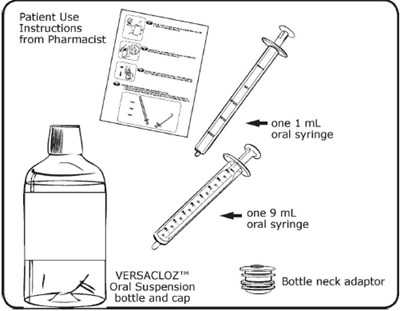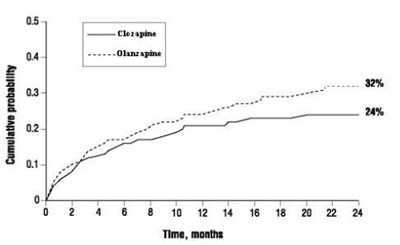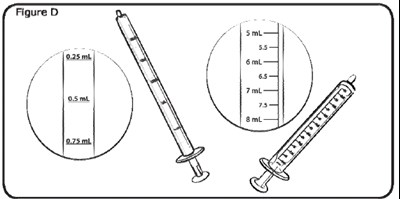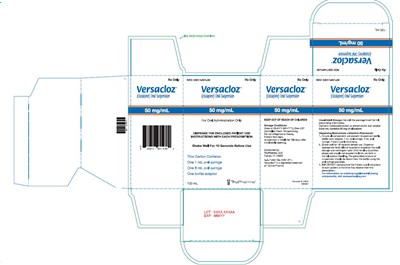Product Images Versacloz
View Photos of Packaging, Labels & Appearance
- symptoms of myocarditis and cardiomyopathy - image 01
- symptoms - image 02
- Description: 8-chloro-11-(4-methyl-1-piperazinyl)-5H-dibenzo[b,e][1,4]diazepine - image 03
- Figure-02 Cumulative Probability - image 04
- Figure-03 Patient Use - image 05
- Figure A Step 1 - image 06
- Figure B Step 2 - image 07
- Figure C Step 3 - image 08
- Figure D-01 - image 09
- Figure D-02 Step 4 - image 10
- Figure E Step 5 - image 11
- Figure F Step 6 - image 12
- Figure G Step 7 - image 13
- Figure H Step 8 - image 14
- Figure I Step 9 - image 15
- Figure J Step 10 - image 16
- Figure K Step 11 - image 17
- Figure L Step 12 - image 18
- Figure M Step 13 - image 19
- Figure N Step 14 - image 20
- Label - image 21
- side effects - image 22
Product Label Images
The following 22 images provide visual information about the product associated with Versacloz NDC 52817-601 by Trupharma Llc, such as packaging, labeling, and the appearance of the drug itself. This resource could be helpful for medical professionals, pharmacists, and patients seeking to verify medication information and ensure they have the correct product.
symptoms of myocarditis and cardiomyopathy - image 01

This text suggests a possible set of symptoms that someone might be experiencing, including chest pain, swollen legs, ankles, and feet, a fast heartbeat, feeling tired, shortness of breath, fever, and dizziness. These symptoms could be indicative of a variety of medical conditions and it is important to seek medical attention if experiencing any of these symptoms.*
symptoms - image 02

This text appears to describe a list of symptoms and potential health issues. These may include feeling sleepy, having a fast or irregular heartbeat, seizures, low blood pressure, confusion, shallow or difficult breathing, coma, and excessive saliva in the mouth. These symptoms could be related to a variety of different medical conditions, and it would be important to seek medical attention if experiencing any of them.*
Description: 8-chloro-11-(4-methyl-1-piperazinyl)-5H-dibenzo[b,e][1,4]diazepine - image 03
![image-03.jpg Description: 8-chloro-11-(4-methyl-1-piperazinyl)-5H-dibenzo[b,e][1,4]diazepine - image 03](https://ndclist.com/assets/spl/images/2592c9a8-fd74-4e0d-a895-b07b014cf355/400x-image-03.jpg)
This text provides the molecular weight of a compound, which is 326.83. No further details are available.*
Figure-03 Patient Use - image 05

This appears to be a set of patient use instructions from a pharmacist on how to use VERSACLOZ™ oral suspension. The instructions mention the use of a 1mL and 9mL oral syringe along with a bottle neck adaptor for the medication bottle and cap.*
Figure A Step 1 - image 06

This text provides instructions on how to prepare VERSACLOZ for use by tightening the cap on the bottle by turning it clockwise and shaking the bottle up and down for 10 seconds. It also includes a reference to Figure A, which is not available.*
Figure B Step 2 - image 07

This text provides instructions on how to remove a bottle cap by pushing it down and turning it counterclockwise, while referencing a diagram labeled "Figure B".*
Figure C Step 3 - image 08

This text appears to be a set of instructions related to using an adaptor for a bottle. The instructions suggest inserting the adaptor into a new bottle until it lines up with the top of the bottle. Unfortunately, there is no information on what type of adaptor or bottle is being referred to.*
Figure D-01 - image 09

This text provides instructions on how to correctly measure a dose of VERSACLOZ using an oral syringe. It advises to select the appropriate syringe based on the prescribed dosage - either the smaller 1mL syringe if the dose is 50mg or less, or the larger 9mL syringe if the dose is more than 50mg. Two figures (D) are referenced to illustrate the correct syringe to use.*
Figure E Step 5 - image 11

This text provides instructions to fill an oral syringe with air by drawing back the plunger. A figure labeled as "Figure E" may provide additional visual instruction.*
Figure F Step 6 - image 12

This text provides instructions on how to use an oral syringe to push air out of a bottle. The user should insert the open tip of the syringe into the bottle neck adaptor and push all the air from the syringe into the bottle by pressing down on the plunger. A reference to a figure is mentioned.*
Figure G Step 7 - image 13

This text provides instructions for administering oral medicine using an oral syringe. It advises to hold the syringe in place and carefully turn the bottle upside down before pulling back on the plunger to draw some of the medicine into the syringe, being careful not to pull the plunger all the way out.*
Figure H Step 8 - image 14

The given text provides instructions on how to remove air from an oral syringe while administering medicine. It advises to push the plunger so that the air disappears, leading to accurate dosage of the medicine. A visual reference in the form of Figure H has also been mentioned.*
Figure I Step 9 - image 15

This text provides instructions for using an oral syringe to measure and draw a specific dose of medicine. The reader is advised to pull back on the plunger to withdraw the specific dose. A corresponding image (Figure I) may provide additional visual support for these instructions.*
Figure J Step 10 - image 16

This text provides instructions on how to properly use an oral syringe to administer medicine. It advises the reader to turn the bottle upside down to fill the syringe and to avoid pushing on the plunger while removing it from the bottle neck adaptor. Additionally, it cautions against storing the medicine in the oral syringe for later use.*
Figure K Step 11 - image 17

This text provides instructions on how to take liquid medicine using an oral syringe. It instructs the reader to place the syringe in their mouth and swallow the medicine slowly. Figure K, which is presumably a visual aid, is not included.*
Figure L Step 12 - image 18

This text provides instructions on how to put the cap back on a bottle after using a bottle neck adaptor. It advises leaving the adaptor in the bottle and then tightening the cap by turning it clockwise. The corresponding figure is mentioned as well.*
Figure M Step 13 - image 19

The text provides instructions on how to clean and fill an oral syringe using warm tap water and a cup. A figure is referenced for further guidance.*
Figure N Step 14 - image 20

This text provides instructions on how to clean an oral syringe by squirting water into a sink or separate container, repeating the process until the syringe is clean. The syringe should air dry and any leftover rinse water should be discarded. Figure N is referenced as a visual aid.*
side effects - image 22

This is a medical text that talks about possible side effects one may experience when taking medication. The listed side effects include sleepiness, dizziness, heart and blood vessel problems, fast heartbeat, passing out, increased sweating, vision problems, headache, shaking movements, low blood pressure, having a lot of saliva in your mouth, dry mouth, stomach and intestinal problems, and nausea.*
* The product label images have been analyzed using a combination of traditional computing and machine learning techniques. It should be noted that the descriptions provided may not be entirely accurate as they are experimental in nature. Use the information in this page at your own discretion and risk.


